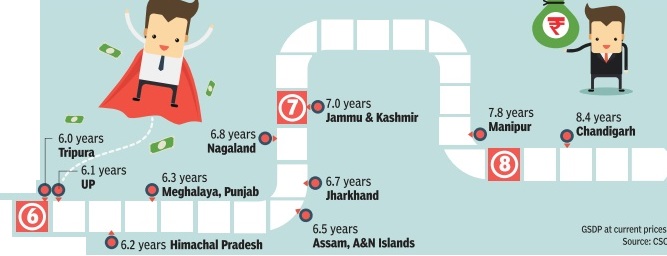Income Distribution:India




This is a collection of articles archived for the excellence of their content. Readers will be able to edit existing articles and post new articles directly |
"Inequality should be measured on income per capita"
Jan 21 2015
Govt data on inequality misleading
Inequality in South Asia is much more glaring than what government data shows because standard yardsticks of measuring income don't reveal the true picture, says a World Bank report `Addressing Inequality in South Asia', released on Tuesday . For instance, the Gini coefficient -the standard measure to gauge income inequality -ranges from 0.28 to 0.40 in this region, suggesting a level of inequality much lower than in countries like Argentina, Malaysia, Chile or Brazil. The caveat to this comparison, however, is that in South Asia inequality is measured on the basis of consumption per capita while in advanced economies as well as Latin America, it is based on income per capita. The consumption-based approach doesn't give the true picture of inequality as it does not cover the spending habits of the richest sections of the population. This is because in these countries, the typical questionnaire for surveys that measure income is focussed on a relatively basic basket of goods and services.
Based on a 59th round NSSO survey that was focussed on measuring wealth (land, building, machinery , financial assets and so) the report estimates that the average net worth of the top 10% of the population in India was 380 times that of the bottom 10%. The net worth could support consumption for 23 years for the top bracket and less than three months for the bottom one.
The huge income difference between the richest and the poorest also means a wide degree of difference in access to basic needs like nutrition, health care and education. Because of these differences, the distribution of wealth in the high economic growth period following liberalization has been more favourable to a much smaller section of society , the report said.
The report said that the total billionaire wealth represented about 10% of India's GDP in 2012, which was an outlier in the ratio of billionaire wealth to GDP among economies of similar development levels. Interestingly , 40% of India's billionaire wealth is estimated to be inheritance while 60% originates from `rent-thick sectors' such as real estate, infrastructure, construction, mining and telecommunications.
Evidently , for a majority of its population, India is not the land of equal opportunity .The income share of India's top 0.01% was less than 0.4% in 1980, but rose to 1.5 to 2% by the end of the 1990s. During this period, the income share of the top 0.1% was 3 to 4.5%, suggesting growth was strongly biased towards the ultra-rich. Up to 2010, India had the gentlest rate of poverty decline in South Asia.
The report classified the Indian population into three groups -the poor, the vulnerable (people just above the poverty line) and the middle class. Between 200405 and 2009-10, about 40% of poor households moved above the poverty line. Similarly about 11% of poor and vulnerable moved into the middle class during the same period. Alarmingly , during the same period, about 14% of the non-poor groups slipped into poverty .
The lack of social security and access to basic social needs like health care, food security and education is the main reason behind this cycle of poverty .